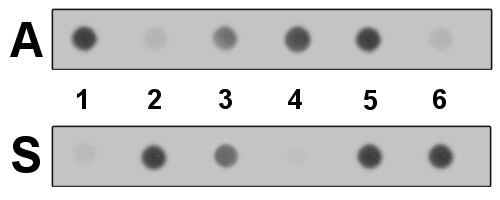 | ||
A dot blot (or slot blot) is a technique in molecular biology used to detect biomolecules, and for detecting, analyzing, and identifying proteins. It represents a simplification of the northern blot, Southern blot, or western blot methods. In a dot blot the biomolecules to be detected are not first separated by electrophoresis. Instead, a mixture containing the molecule to be detected is applied directly on a membrane as a dot, and then is spotted through circular templates directly onto the membrane or paper substrate. This differs from the western blot because protein samples are not separated electrophoretically. This is then followed by detection by either nucleotide probes (for a northern blot and southern blot) or antibodies (for a western blot).
Contents
The technique offers significant savings in time, as chromatography or gel electrophoresis, and the complex blotting procedures for the gel are not required. However, it offers no information on the size of the target biomolecule. Furthermore, if two molecules of different sizes are detected, they will still appear as a single dot. Dot blots therefore can only confirm the presence or absence of a biomolecule or biomolecules which can be detected by the DNA probes or the antibody.
Because dot blot does not require complicated instrument to operate, lots of dot blot assays are developed using antibodies with high specificity to detect different protein targets. Dot blot is also used to evaluate or screen the effectiveness of the antibodies.
Protocol
Below is just a general guide line for a antigen-antibody-antibody dot blot assay protocol. Specific concentration need to be determined for each assay. Other types of dot blot assays, such as antibody-antigen-antibody can be performed in a similar fashion.
1. spot 1-2 microliter of antigen on to a piece of membrane, let air dry for 30 min or longer;
2. incubate with blocking buffer for 30 min -2 hr;
3. rinse with rinsing buffer, 3x5 min;
4. incubate with primary antibody, 30 min - 2 hr;
5. rinse with rinsing buffer, 3x5 min;
6. incubate with enzyme-labeled secondary antibody, 30 min - 2 hr;
7. rinse with rinsing buffer, 3x5 min;
8. add enzyme substrate, wait 5-10 min;
9. detect by eye or with colorimetric or chemiluminescent imaging system.
Methods
Dot blot is originally performed on a piece of nitrocellulose membrane or PVDF membrane. After the protein samples are spotted onto the membrane, the membrane is placed in a plastic container and sequentially incubated in blocking buffer, antibody solutions, or rinsing buffer on a shaker. Finally, for chemiluminescence imaging, the piece of membrane is wrapped in a transparent plastic film filled with enzyme substrate.
Vacuum-based dot blot apparatus (Bio-dot or Bio-slot from BioRad) has been used to facilitate the rinsing and incubating process by using vacuum to extract the solution from underneath the membrane, which is assembled in between several layers of plates to ensure good seal between sample wells, hold waste solution, and deliver suction force. For chemiluminescence signal detection, the apparatus is dissembled and the membrane is taken out and wrapped in a transparent plastic film filled with enzyme substrate.
Vitrozm's 96 well Zoom Blot method uses an absorption plug to wick away the solution from the membranes, which are individually assembled in each well. The Zoom Plate is a disposable self-standing device, without any external vacuum or set up apparatus, which allows dot blots to be performed much easier and faster. The user never needs to handle a piece of membrane as in older methods. Zoom Blot's 96 well plate format allows convenient signal detection and quantification using 96 well plate reader or imaging system.
What can this test detect?
The sensitive dot blot test can be used to detect the Chlamydia trachomatis infection and other sexually transmitted diseases. Dot blot is used to detect Antidiacyltrehalose Antibodies in Tuberculous patients and Typhoid Fever.
